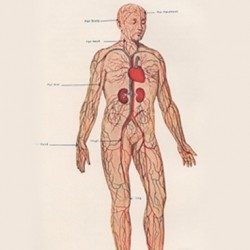 Developing a new treatment for septic shock
Developing a new treatment for septic shock
1 million people die each year from septic shock and severe sepsis in the USA alone. Worldwide, sepsis is the primary cause of death in intensive care units. And yet the treatments used in hospitals have barely changed in the last 50 years. Now research from the Nitric Oxide Signalling Group has unearthed a new way to tackle this devastating condition.
Sepsis is a severe whole-body inflammatory response to an infection.During septic shock, blood vessels dilate, leading to a rapid decline in blood pressure. If this plunging pressure isn’t quickly rectified,vital organs grind to a halt and the patient dies. “Sepsis kills so many people, and the current treatments are quite arcane,” says James Leiper, who led the study. Current survival rates lie at roughly 50%,and have not significantly improved in decades.
Pharmaceutical treatments are notable by their absence, and attempts todevelop drugs for this purpose have had limited success, until now. Oneof the major factors causing blood vessels to dilate is a signallingmolecule found throughout the body, called nitric oxide (NO).
“In healthy people, NO causes vessel dilation to improve blood flow,for example during exercise,” explains Leiper. “But in systemicinflammatory situations, the body makes huge amounts of NO, and thevessels completely dilate.” Reducing NO at times of septic shock,therefore, could save lives. But, warns James, “reducing NO in anon-selective way is unlikely to be useful, as it has both pathologicaland protective roles throughout the body. You’ve got to find a way ofdoing it within certain tissues, at specific times.”
This research, published in Arteriosclerosis, Thrombosis, andVascular Biology, has achieved that. In the body, the pathway thatproduces NO is regulated by a molecule called ADMA. In turn, ADMA isbroken down by an enzyme, DDAH, in blood vessels. Inhibiting DDAH leadsto a rise in ADMA, which blocks NO production, hence raising bloodpressure as vessels cannot dilate. Crucially, DDAH is expressed in thebody’s vasculature, but is less crucial elsewhere, meaning that thesilencing of DDAH does not disrupt other bodily functions.
“In this paper, we’ve identified a gene that regulates NO production[DDAH], and shown that if you ‘knock it out’ in experimental animals,you find a beneficial effect in sepsis. We then went a step further,and asked if we could make a small molecule to inhibit the product ofthe gene, to similarly improve function.” In the innocuously namedL-257 the team have such a molecule.
This non-toxic molecule is a candidate drug for the treatment of septicshock. This proof-of-principle revelation is the culmination of over adecade’s work for Leiper and his team. What started 10 years ago, withthe cloning of the DDAH1 gene, is now taking strides towards its firsthuman clinical trials. “When I started working in medical research theidea was to eventually do things to improve health, and it would befantastic to now see a compound we made benefit humans.”
Reference: Nandi M, Kelly P, Torondel B, Wang Z, Starr A, Ma Y,Cunningham P, Stidwill R,Leiper J. (2012) Genetic and PharmacologicalInhibition of Dimethylarginine Dimethylaminohydrolase 1 Is Protectivein Endotoxic Shock. Arteriosclerosis, Thrombosis, and Vascular Biology| Abstract
Photo credit: Virtue’s Household Physician, c.1925
